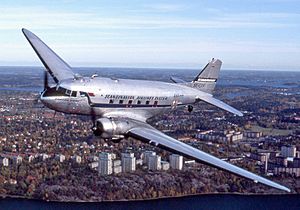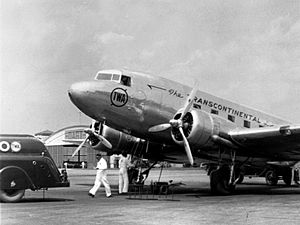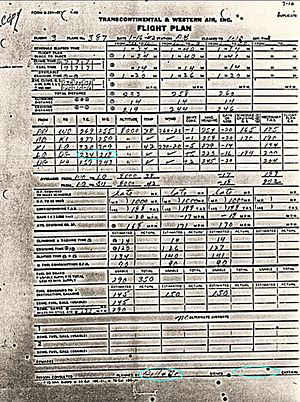TWA Flight 3 facts for kids

Douglas DC-3 similar to accident aircraft
|
|
| Accident | |
|---|---|
| Date | January 16, 1942 |
| Summary | Controlled flight into terrain due to pilot error |
| Site | Potosi Mountain, Nevada, U.S. 35°57′04″N 115°29′29″W / 35.9510°N 115.4914°W |
| Aircraft type | Douglas DC-3 |
| Operator | Transcontinental and Western Air |
| Registration | NC1946 |
| Flight origin | New York, New York, U.S. |
| 1st stopover | Indianapolis, Indiana, U.S. |
| 2nd stopover | St. Louis, Missouri, U.S. |
| 3rd stopover | Albuquerque, New Mexico, U.S. |
| 4th stopover | Las Vegas Airport, Las Vegas, Nevada, U.S. |
| Destination | Burbank, California, U.S. |
| Occupants | 22 |
| Passengers | 19 |
| Crew | 3 |
| Fatalities | 22 |
| Survivors | 0 |
TWA Flight 3 was a passenger plane operated by Transcontinental and Western Air (TWA). On January 16, 1942, this Douglas DC-3 aircraft crashed into a mountain in Nevada. All 22 people on board died. This included famous movie star Carole Lombard.
The plane was flying from New York City to Burbank, California. It made several stops along the way, including Las Vegas, Nevada. The crash happened about 15 minutes after the plane left Las Vegas. Investigators later found that the crash was caused by the pilot making a mistake in navigation.
The Flight's Journey
TWA Flight 3 was a long trip across the United States. It started in New York City and was headed to Burbank, California. The plane made stops in cities like Indianapolis, St. Louis, Albuquerque, New Mexico, and Las Vegas.
On the morning of January 16, 1942, actress Carole Lombard boarded Flight 3 in Indianapolis. Her mother and her publicist from MGM were with her. Carole Lombard was married to actor Clark Gable. She was returning home after helping to sell special "war bonds." These bonds helped the United States pay for World War II. She had helped raise over $2 million.
When the plane landed in Albuquerque, Carole Lombard and her group were asked to give up their seats. This was to make room for 15 United States Army Air Corps soldiers. They were also flying to California. Lombard argued that her war bond work was important. She convinced the airport staff to let her group stay on the flight. Other passengers, like violinist Joseph Szigeti, had to leave instead.
The flight crew also changed in Albuquerque. The new captain decided to fly straight to Las Vegas. They skipped a planned refueling stop in Arizona. This was because the plane had more passengers and strong winds were expected.
After a quick stop in Las Vegas, the plane took off for Burbank. It was a clear, dark night with no moon. About 15 minutes later, the plane crashed into a steep cliff. This happened on Potosi Mountain. The plane was flying almost 7 miles off its planned path. Everyone on board died in the crash.
Why the Crash Happened
The Civil Aeronautics Board (CAB) investigated the accident. This group was in charge of looking into plane crashes. They found that Flight 3 flew in a straight line from Las Vegas. But it was about 10 degrees to the right of the correct path. This path led the plane into high mountains. The plane was flying at 8,000 feet, but the mountains were taller.
Investigators believed the crew was not using the correct radio navigation. This navigation system would have kept them safe from mountains. Instead, they seemed to be using a compass to guide the plane. Most of the special lights that guide planes were turned off because of World War II. However, one important light was working.
A key piece of evidence was the flight plan. The co-pilot filled it out in Albuquerque. But the captain did not sign it, even though he was supposed to. The plan showed the plane would fly a magnetic course of 218 degrees from Las Vegas. This was the path the plane actually flew into the mountain.
The investigators realized this was a mistake. Flying at 8,000 feet on this course was too low for the mountains ahead. The mountains reached about 8,500 feet. The investigators thought the pilots might have been confused. They had flown to Burbank more often from a different airport called Boulder City. From Boulder City, a 218-degree course would have been correct. The crew likely used the wrong course by mistake.
The CAB looked at other TWA flight plans. They found another flight plan that also showed the same incorrect 218-degree course from Las Vegas. TWA's chief pilot said this was "obviously a mistake."
The CAB decided the main reason for the crash was:
- The captain did not use the correct navigation tools after leaving Las Vegas.
They also listed other things that contributed to the crash:
- The crew used a wrong compass course.
- Most of the guiding lights were turned off because of the war.
- The pilot did not follow TWA's instructions. These instructions told pilots to stay on the correct radio signals.
A Different Idea
Some people have wondered if there was another reason for the crash. In a book called My Lunches with Orson, Orson Welles said a security agent told him something different. Welles claimed the plane was shot down by Nazi agents. He said they knew the plane's route. He also claimed the news was kept secret. This was to prevent people from acting against Americans with German backgrounds. However, this idea has been questioned by others who have studied the crash.




